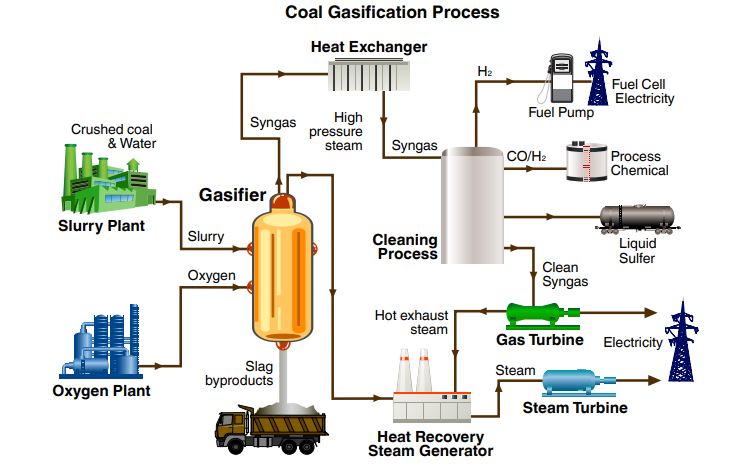Ahmedabad
(Head Office)Address : 506, 3rd EYE THREE (III), Opp. Induben Khakhrawala, Girish Cold Drink Cross Road, CG Road, Navrangpura, Ahmedabad, 380009.
Mobile : 8469231587 / 9586028957
Telephone : 079-40098991
E-mail: dics.upsc@gmail.com

Coal Gasification
News: The Ministry of Coal has prepared a National Mission document to achieve 100 MT (Million Tonnes) Coal Gasification by 2030.
About:
• Coal gasification is a process in which coal is partially oxidised with air, oxygen, steam or carbon dioxide to form a fuel gas.
• This gas is then used instead of piped natural gas, methane and others for deriving energy.
• In-situ gasification of coal – or Underground Coal Gasification (UCG) – is the technique of converting coal into gas while it is still in the seam and then extracting it through wells.
• It produces Syngas which is a mixture consisting primarily of methane (CH4), carbon monoxide (CO), hydrogen (H2), carbon dioxide (CO2) and water vapour (H2O). Syngas can be used to produce a wide range of fertilizers, fuels, solvent and synthetic materials.
Significance of Coal Gasification:
• Steel companies typically use coking coal in their manufacturing process. Most of the coking coal is imported and is expensive. To cut costs, plants can use syngas, which comes from coal gasification plants in the place of coking coal.
• It is primarily used for electricity generation, to produce chemical feedstocks.
• The hydrogen obtained from coal gasification can be used for various purposes such as making ammonia, powering a Hydrogen Economy.
• India’s hydrogen demand is likely to increase to 11.7 million tonnes by 2030 from 6.7 million tonnes per year as of now. Refineries and fertiliser plants are the largest consumers of hydrogen now, which is being produced from natural gas. It can be produced through coal in the processes during coal gasification.
Concerns associated with Coal Gasification:
• Coal gasification actually produces more carbon dioxide than a conventional coal-powered thermal power plant. According to CSE estimates, one unit of electricity generated by burning gasified coal generates 2.5 times more carbon dioxide than what would result when burning the coal directly.
• The syngas process converts a relatively high-quality energy source (coal) to a lower quality state (gas) and consumes a lot of energy in doing so. Thus, the efficiency of conversion is also low.

Address : 506, 3rd EYE THREE (III), Opp. Induben Khakhrawala, Girish Cold Drink Cross Road, CG Road, Navrangpura, Ahmedabad, 380009.
Mobile : 8469231587 / 9586028957
Telephone : 079-40098991
E-mail: dics.upsc@gmail.com
Address: A-306, The Landmark, Urjanagar-1, Opp. Spicy Street, Kudasan – Por Road, Kudasan, Gandhinagar – 382421
Mobile : 9723832444 / 9723932444
E-mail: dics.gnagar@gmail.com
Address: 2nd Floor, 9 Shivali Society, L&T Circle, opp. Ratri Bazar, Karelibaugh, Vadodara, 390018
Mobile : 9725692037 / 9725692054
E-mail: dics.vadodara@gmail.com
Address: 403, Raj Victoria, Opp. Pal Walkway, Near Galaxy Circle, Pal, Surat-394510
Mobile : 8401031583 / 8401031587
E-mail: dics.surat@gmail.com
Address: 303,305 K 158 Complex Above Magson, Sindhubhavan Road Ahmedabad-380059
Mobile : 9974751177 / 8469231587
E-mail: dicssbr@gmail.com
Address: 57/17, 2nd Floor, Old Rajinder Nagar Market, Bada Bazaar Marg, Delhi-60
Mobile : 9104830862 / 9104830865
E-mail: dics.newdelhi@gmail.com